Alpheus Baker Hervey, 1839 - 1931
by Brian Stevenson
last updated December, 2020
A Universalist Minister, the Reverend A.B. Hervey was also an authority on microscopy and botany. He was a founding member of the American Society of Microscopists (later the American Microscopical Society), a member and officer of the Subsection of Microscopy / Section of Histology and Microscopy of the American Association for the Advancement of Science, an officer of the American Postal Microscopical Club, and member of several local scientific societies.
Hervey had a particular interest in sea weeds, mosses, and lichens. During the 1870s-90s, he produced microscope slides for exchange and sales. His preparations focused on plant reproductive tissues and other aspects that would be of scientific value. In 1881, The American Monthly Microscopical Journal described Hervey’s mounts: “All of these specimens are very instructive and, so far as we know, they are not to be found among the slides sold by the dealers. We hope Mr. Hervey will receive many orders, for the preparations are well worth the price asked for them”.
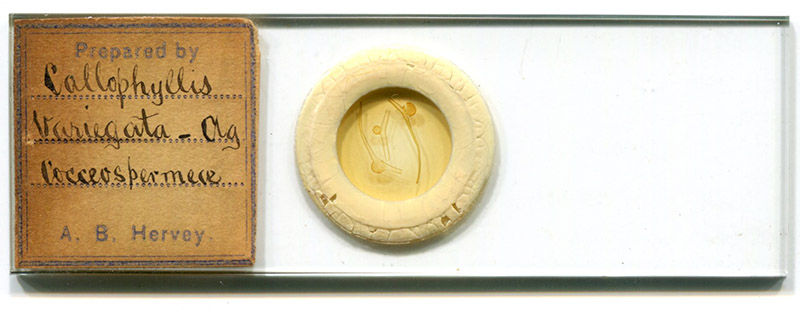
Figure 1.
A ca. 1881 microscope slide by A.B. Hervey, of reproductive tissue (“cocceospermeae”) of the sea weed Callophyllis variegata, from southern South America. He described this specimen to the Troy Scientific Association in 1879, and advertised sale of such slides in 1881 (see Figure 3).
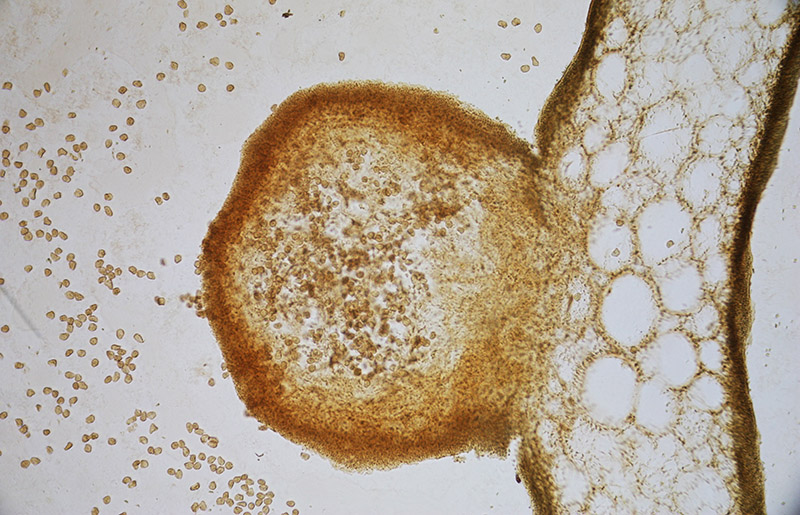
Figure 2.
“Cocceospermeae” of Callophyllis variegata, photographed with a 10x objective and C-mounted digital SLR camera.
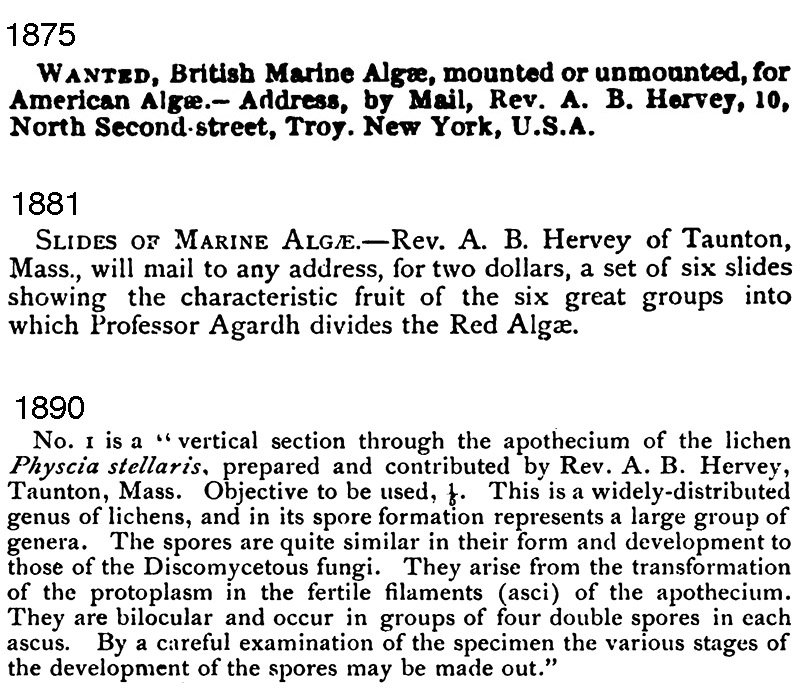
Figure 3.
Some published information on A.B. Hervey’s microscope slides: An 1875 offer to exchange mounted and unmounted specimens of marine algae (sea weeds), published in the English magazine “Hardwicke’s Science-Gossip”; An 1881 advertisement to sell series of 6 slides of sea weed reproductive tissues - the slide shown in Figures 1 and 2, above, came from such a set, published in “The American Naturalist”; An 1890 description of a Hervey slide that was included in a circulating box of the American Postal Microscopical Club, published in “The American Monthly Microscopical Journal”.
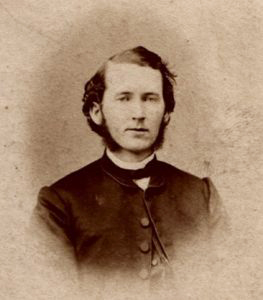
Figure 4.
The Reverend A.B. Hervey. Adapted for nonprofit, educational purposes from https://commons.trincoll.edu/cschneider/bermuda-flora.
A.B. Hervey was born on March 31, 1839 in Triangle, New York, a small town in the center of the state near Ithaca and Binghamton. He was the third child / third son of Joseph and Rhoda (nee Baker) Hervey. When Alpheus was 8, the family moved some 150 miles west, to Bingham, Pennsylvania, where his father established a farm.
While his two elder brothers were destined to also be farmers, Alpheus was provided with education at Alfred Academy (some 25 miles north of Bingham) and Oxford Academy (near the old home of Triangle). A memoriam reported that “At 16 he left home to teach school and worked in hayfields and lumber camps during the summer”. Hervey then attended St. Lawrence University, where he studied theology yet also “specialized in botany and microscopy”. After graduating in 1861, Hervey served as Pastor of several Universalist churches in New York, Massachusetts, and Maine. He also enlisted in the U.S. Army during the Civil War (1861-1865), but was not mustered in.
In 1863, while serving in Malone, New York, Hervey married Sarah Eliza Andrew. The couple had two children, both sons.
After moving to Troy, New York, in the early 1870s, Hervey become of the Microscopical Section of the Troy Scientific Association. He was elected Vice Chairman in 1878.
Hervey’s fascination for sea weeds was evident as early as 1875, when he placed an offer in the English Hardwicke’s Science-Gossip, asking for “British Marine Algae, mounted or unmounted, for American Algae” (Figure 3).
Moreover, his ongoing studies led him to develop novel mounting methods. As reported by the Journal of the Royal Microscopical Society in 1878, “At the April Meeting of the Microscopical Section of the Troy (U.S.) Scientific Association, the Rev. A.B. Hervey described a method, which he had recently devised. In his study of the Algae and Lichens he had been troubled, as others have been, by the difficulty of permanently mounting specimens while studying them, without waste of time or change of arrangements, Most of the methods of mounting either ruin such objects entirely or else require considerable time, care, and special appliances that are troublesome to a busy student, and therefore instructive specimens are lost. The objects may be transferred from water to Farrant's solution of gum and glycerine, and mounted without delay; but the structure is not well preserved, and air bubbles are likely to be obstinately present. The objects show best in distilled water, sea-water, camphor-water, &c.; and to mount them instantly and with uniform success he prepares cells of the gum and glycerine solution put on by means of the turn-table in the usual way. Having made cells of the required depth, and laid them aside until thoroughly dry, the inner half of the width of the cell is varnished on the turn-table with gold size, which is also allowed time to dry perfectly. Objects in water are arranged and covered in these cells with ease, and are ready after lying aside for a time varying from a few minutes to a few hours, to receive a coat of gold size or other varnish, the fluid that exudes from the cell in pressing down the cover-glass having dissolved enough of the gum cell to hold the cover in position. It has not been found that the cell is too much affected by the fluid; but if it should be so, the cell could be made of the usual cements, insoluble in water, and then coated with a thin layer of gum”.
In 1875, Hervey and several other colleagues formed a national society for sharing microscope slides, which they called the American Postal Microscopical Club. Hervey was the first club secretary.
Of relevance to the Hervey slide shown above in Figures 1 and 2, the minutes of the May 6, 1878 meeting of the Microscopical Section of the Troy Scientific Society read, “Rev. A.B. Hervey, Vice-Chairman of the Section, gave a very clear summary of the classification of algae by means of fructification, and illustrated the six principal groups into which the Red sea-weeds are divided, by the following preparations: No. 1, Ceramium rubruin Ag., showing in its various stages of development, the fruit produced by the simple subdivision of the cell contents of a fructified mother-cell; No. 2, Callophyllis variegata Ag., having the nucleus of the cystocarp compound, and the masses of spores separated by intervening sterile cells; No. 3, Plocamium procerum Ag., from the highest order in the third series, the spores being produced by the gradual development of bead-like strings of small cells, or ‘spore threads’, arising from a common base or centre and often branched, and when fully developed, filling the cystocarp with a mass of sub-angular spores, all the cells of a given spore-thread appearing to develop simultaneously, but some of the threads in these sections, not having been fecundated and developed, appearing in their original state and form; No. 4, Curdiwa laciniata Harvey, showing characteristic fruit of the series where a mass of fine, closely packed, moniliform ‘spore threads’, arising from a basal placenta, form the spores by the successive ripening and falling off of the end cells of the fecundated threads; No. 5, Gelidium cartilagineum Grev., illustrating the series having an immersed cystocarp, a placenta central as in this species or more frequently basal or parietal, and club-shaped spores developed at the end of very short spore threads; and No. 6, Polysiphonia fibrillosa Grev., having the cystocarp external and somewhat highly developed, and the spores large and club-shaped. The specimens were mounted in sea-water and glycerine, by the instantaneous method described in the May number of the ‘Naturalist’, and showed the typical fructification of the different series with great distinctness. After study and discussion by the section, the series of slides was tendered as a special box to the Postal Club’." Note, however, that the slide in Figure 1 used balsam mountant, and was part of a set that Hervey produced for sale in 1881.
The first National Microscopical Congress of the U.S.A. was held in 1878, and A.B. Hervey served as its chairman. That meeting resulted in the formation of the American Society of Microscopists.
Along with Eugene A. Rau, Hervey published Catalogue of North American Musci (i.e. mosses) in 1879. Hervey published several additional scientific and popular books on botany, including Sea Mosses, a Collector’s Guide and Introduction to the Study of Marine Algae (1881), Beautiful Wild Flowers of America (1882), Flowers and Ferns of America (1885), Wayside Flowers and Ferns (1887), and The Algae of Bermuda (1917) (Figure 5). In addition, he translated two important botany texts from German into English: The Microscope in Botany by Julius Wilhelm, in 1885, and Microscopic Botany by Eduard Strasburger, in 1887 (Figure 6).
Hervey joined the American Association for the Advancement of Science (A.A.A.S.) in 1879. He soon became an officer of the Subsection of Microscopy, and was its Chairman when it became the Section of Histology and Microscopy in 1881.
Around 1879, Hervey was re-assigned to a church in Taunton, Massachusetts. His periodic transfers probably explain why Hervey’s specimen labels do not include an address.
A series of six slides that showed reproductive tissues of red algae was produced in 1881 (Figures 1-3). A second series was issued in 1882, as reported by The American Monthly Microscopical Society, “We take pleasure in calling attention to some preparations of the Rev. Mr. Hervey, of Taunton, Mass., showing the methods of fructification of the marine algae. He had with him at Montreal, a second series of slides illustrative of the subject, which we found to be very instructive. They must prove of great practical value to beginners in the study of marine alga, and doubtless also to others who are more advanced, for it requires skill in preparing the sections, and a careful selection of the plants in the proper stage of growth, to obtain satisfactory slides of this kind”.
Wife Sarah died in 1884.
A.B. Hervey paused his ministry in 1888, taking on the Presidency of his alma mater, St. Lawrence University, in Canton, New York. He served in that position until 1894.
Hervey’s contemporaries frequently mention his role in mentoring Owen D. Young (1874-1962), who became Chairman of the Board of Directors of General Electric and founded the Radio Corporation of America (RCA). Hervey met Young during his time at St. Lawrence, when the latter was a farm boy. Hervey provided Young with an opportunity to attend college, thereby enabling the career of one of the most important American industrialists of the early twentieth century. Young remained grateful, and rushed to Hervey’s bedside as he lay dying.
After resigning from the Presidency, Hervey moved to Brooklyn, New York, then to Bath, Maine by 1900. He served as a minister in Bath until just before his death.
In 1921 Hervey married Hanna Rion, but she died only three years later.
The nineteen teens and twenties were marked by frequent trips to Bermuda, where Hervey acquired data for his The Algae of Bermuda.
The 1930 census listed A.B. Hervey at two addresses, as a boarder in Bath, Maine, and with his son in Brooklyn, indicating that he moved homes during that time period. On March 10, 1931, “The Rev. Dr. Alpheus Baker Hervey, oldest graduate of St. Lawrence University and second president of that institution, an old friend of Owen D. Young, died at his home, 16 McKenna Street, after a lingering illness. He was in his ninety-second year”.
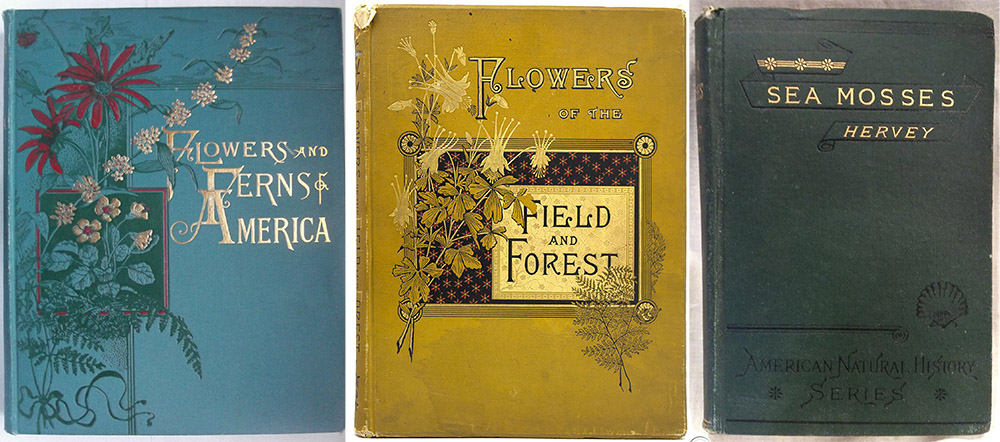
Figure 5.
Covers of some of A.B. Hervey’s books. Adapted for nonprofit, educational purposes from internet retail sites.

Figure 6.
Title pages of two botany books that A.B. Hervey translated from German into English.
Resources
Ackert, James E. (1959) Milestones in the history of the American Microscopical Society, Transactions of the American Microscopical Society, Vol. 78, pages 1-7
The American Journal of Microscopy and Popular Science (1878) Microscopical Section, Troy Scientific Association, Vol. 3, page 264
The American Monthly Microscopical Journal (1881) The American Society of Microscopists, Vol. 2, page 141
The American Monthly Microscopical Journal (1881) Microscopical Section of the A.A.A.S., Vol. 2, page 172
The American Monthly Microscopical Journal (1881) Note on slides provided by A.B. Hervey, Vol. 2, page 218
The American Monthly Microscopical Journal (1882) Note on slides provided by A.B. Hervey, Vol. 3, page 177
The American Monthly Microscopical Journal (1890) Report upon the Postal Club boxes, Vol. 11, page 10
The American Naturalist (1878) Microscopical Section, Troy Scientific Association, Vol. 12, pages 572-574
The American Naturalist (1881) Advertisement from A.B. Hervey, Vol. 15, page 1030
Arrival records of A.B. Hervey returning to New York from Hamilton, Bermuda (1914, 1923, 1924, 1925 and other years) accessed through ancestry.com
Behrens, Julius Wilhelm, and A.B. Hervey (translator) (1885) The Microscope in Botany, S.E. Cassino, Boston
Brooklyn, New York, City Directory (1896) “Hervey Alpheus B (Rev.) h Surf av n W 19th, Hervey Chas. S. editor, Wash’n c Johnson, h Surf av n W 19th”, page 650
Club Directory of the United States (1888) “American Postal Microscopical Club, Troy, N.Y., Rev. A.B. Hervey, (of Taunton, Mass.)”, Clucas, New York, page 61
Collins, Frank S., and Alpheus B. Hervey (1917) The Algae of Bermuda, American Academy of Arts and Sciences, Cambridge, Massachusetts
Craig W. Schneider's Seaweed Lab (accessed December, 2020) History of Seaweed Work in Bermuda, https://commons.trincoll.edu/cschneider/bermuda-flora/
Hardwicke’s Science-Gossip (1875) Exchange offer from A.B. Hervey, Vol. 11, page 96
Harper's New Monthly Magazine (1875), Vol. 51, page 303
Hervey, A.B. (1881) Sea Mosses, a Collector’s Guide and an Introduction to the Study of Marine Algae, S.E. Cassino, Boston
Hervey, A.B., and Isaac Sprague (1882) Beautiful Wild Flowers of America, S.E. Cassino, Boston
Hervey, A.B., and Isaac Sprague (1883) Flowers of the Field and Forest, S.E. Cassino, Boston
Hervey, A.B., and Isaac Sprague (1889) Wayside Flowers and Ferns, L.C. Page & Co., Boston
Journal of the Royal Microscopical Society (1878) Fluid mounting, Vol. 1, page 283
The National Cyclopaedia of American Biography (1900) Hervey, Alpheus Baker, Vol. 10, page 200
New York Sun (1931) Dr. A.B. Hervey, March 11 issue
New York Times (1931) Dr. Hervey, mentor of Owen Young, dies, March 11 issue
Proceedings of the American Association for the Advancement of Science (1904) Members, page 100
Rau, Eugene A., and A.B. Hervey (1879) Catalogue of North American Musci, Rau and Hervey, Taunton, Mass.
Strasburger, Eduard, and A.B. Hervey (translator) Microscopic Botany, S.E. Cassino, Boston
Taunton Directory (1889) “Hervey Alpheus B. Rev. removed to Canton, N.Y.”, page 115
U.S. census and other records, accessed through ancestry.com





